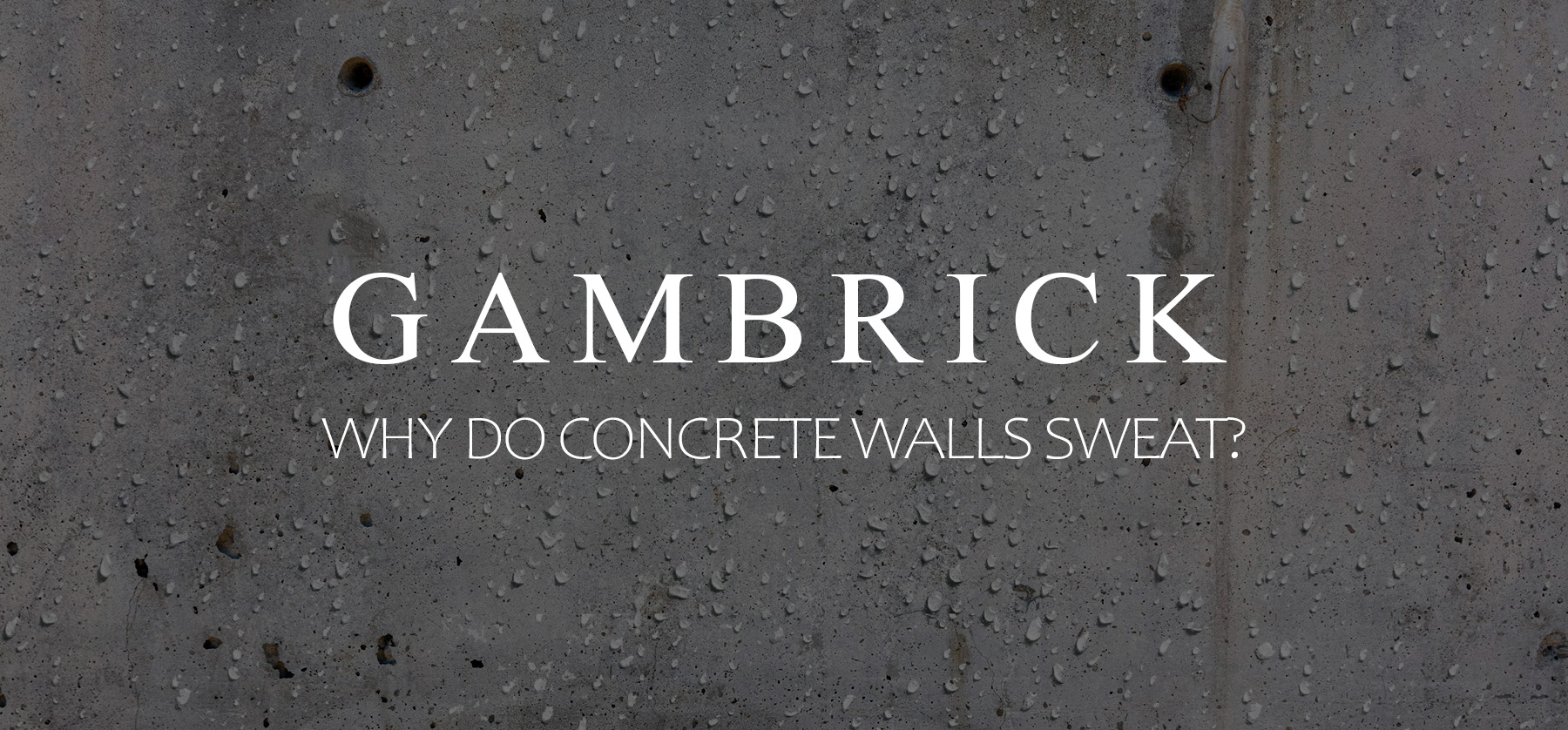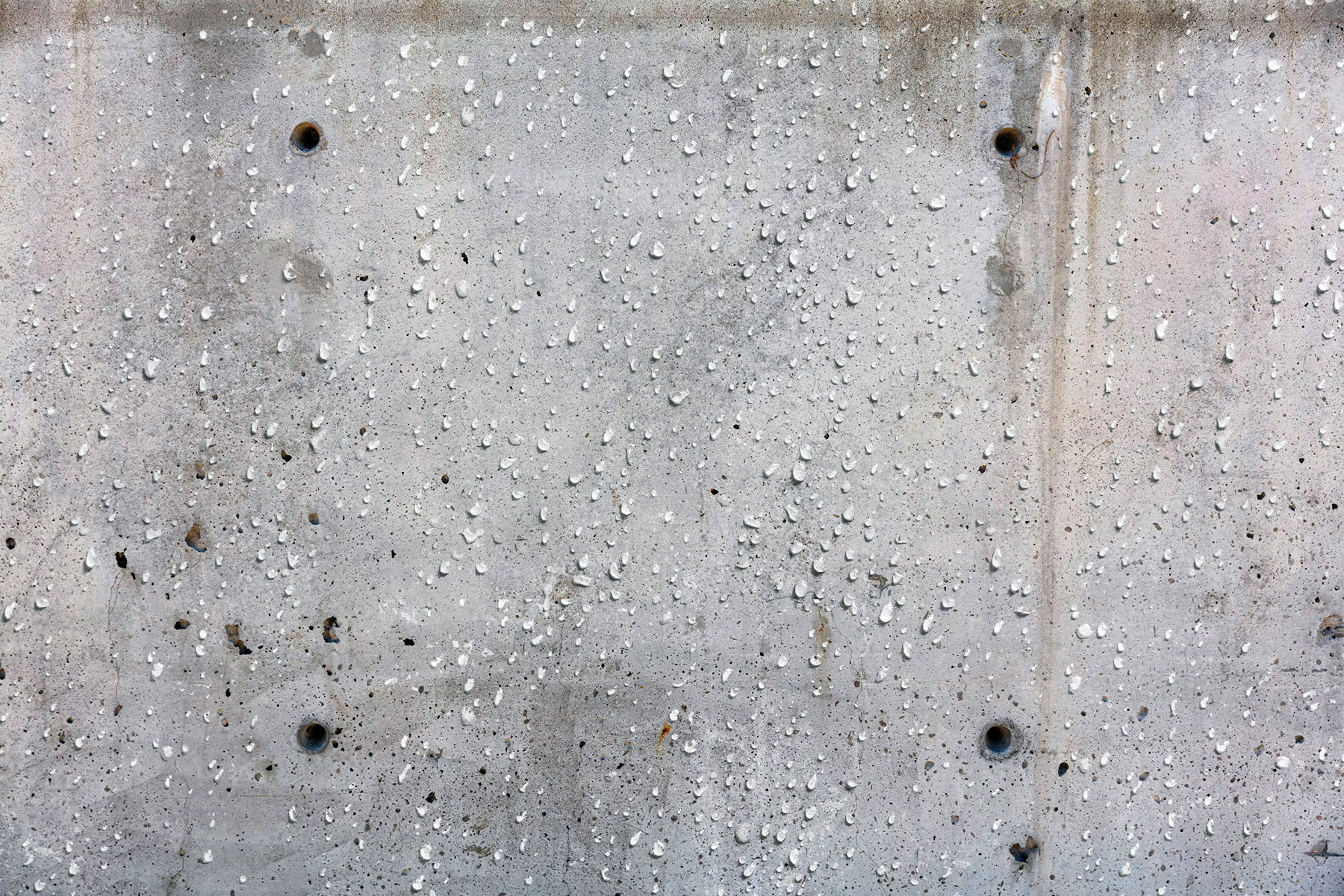Why Do Concrete Walls Sweat?
Concrete walls sweat when the temperature of the concrete surface is lower than the dew point of the air. This causes moisture in the air to condense on the surface of the concrete. The exposed concrete walls in most unfinished basements can experience this type of condensation. Many people mistake moisture on the walls for water seeping through the concrete, and in some cases it is, but usually it’s caused by warm, moist air settling on the cooler surface of the concrete. Once the warm air cools, its moisture is released, which show up as water droplets on the wall. These droplets make the wall appear as if its sweating.
Concrete sweating is a common problem in buildings and structures with solid concrete walls. It’s more common in humid environments or during warmer months when the air holds more moisture.
Concrete sweating can be unsightly, may cause damage to the surface of the concrete and creates a breeding ground for mold and mildew.
There are a few factors that can contribute to concrete sweating.
- Relative humidity of the air. When the air is more humid, it has a higher capacity to hold moisture. This makes it more likely moisture will condense on the surface of the concrete.
- The temperature difference between the air and the concrete surface. The larger the temperature difference, the more likely it is for moisture to condense on the concrete.
There are a few ways to prevent or reduce concrete sweating. One option is to increase ventilation in the space to help reduce humidity. This can be achieved by using fans or by opening windows and doors to allow for more airflow. Another option is to insulate the concrete walls to help reduce the temperature difference between the air and the concrete surface.
How To Prevent Concrete Walls From Sweating?
Concrete walls sweat when the temperature of the concrete surface is lower than the dew point of the air. This causes moisture to condense on the surface of the concrete. To prevent or reduce concrete sweating, it’s important to control the moisture content in the air and the temperature difference between the wall and air.
When concrete walls sweat it can be unsightly and lead to damage. The concrete can start to deteriorate and mold, mildew and bacteria can grow.
Preventing concrete walls from sweating is important in order to avoid prevent damage and the growth of mold and mildew. There are a few things you can do to prevent or reduce concrete sweating.
- Increase ventilation in the space: This can help reduce humidity in the air, which is one of the main factors that can contribute to concrete sweating. Using fans or opening windows and doors can help increase airflow and reduce humidity in the air.
- Insulate the concrete walls: This helps reduce the temperature difference between the air and the concrete. When the temperature of the air and concrete are closer, there’s less chance moisture will condense on the surface. There are a variety of insulation materials that can be used for this purpose, including foam board, fiberglass, and spray foam insulation.
- Keep the concrete walls dry and clean: Sweep or wipe the surface of the walls regularly. This helps reduce the likelihood of mold growth.
- Dry the air: Use a dehumidifier to remove excess moisture from the air.
There are a few steps you can take to prevent or reduce concrete walls from sweating. These include increased ventilation, insulation, using a dehumidifier and keeping the surface dry and clean. By following these steps, it’s possible to prevent sweating which can result in damage and/or mold growth.
What Causes Concrete Walls To Sweat?
Concrete walls can sweat when the temperature of the concrete surface is lower than the dew point of the air. This causes moisture in the air to condense on the surface of the wall which looks like sweat.
There are a few factors that contribute to concrete sweating.
- Relative humidity of the air: When the air is humid it’s holding a lot of moisture. This makes it more likely that the moisture will condense on the surface of the concrete.
- The temperature difference between the air and the concrete surface: The larger the temperature difference, the more likely it is for moisture to condense on the concrete.
Concrete sweating is a common problem in buildings and homes with concrete walls. It’s worst in humid climates or during warm months when the air holds more water.
Concrete sweat can be unsightly and may cause damage to the surface of the concrete. It can also create a breeding ground for mold and mildew.
The only ways to prevent concrete sweat are to remove moisture from the air or to regulate the temperature difference between the walls and air. This can be achieved by insulating the walls, promoting ventilation or using a dehumidifier.
Wiping the walls and keeping them clean can help prevent damage and mold, but it doesn’t help reduce condensation much.
Why Is Concrete Sweating On Walls A Problem?
Concrete sweating, or the condensation of moisture on the surface of concrete walls, can be a problem for a few reasons.
- First, it can be unsightly. When moisture condenses on the surface of the concrete, it can leave behind streaks or puddles that can cause staining.
- Second, concrete sweating can cause damage to the surface of the concrete. The moisture that condenses on the surface can seep into any cracks or imperfections in the wall. This may lead to further deterioration and weakening of the structure.
- Third, concrete sweating can create a breeding ground for mold and mildew. The combination of moisture and a cool surface creates the ideal conditions for mold and mildew to grow. This can be harmful to both the structure and to the health of those living or working in the space. And once mold starts to grow, it can quickly spread to other areas of the house.
Concrete sweating can be a problem due to its unsightly appearance, the potential to cause damage to the concrete surface, and its ability to create a breeding ground for mold and mildew.
How Do You Keep Moisture Out Of Concrete Walls?
The best way to prevent moisture from entering concrete walls is to seal the surface of the concrete. This can be done using a concrete sealer, which is a protective coating that helps to prevent water and other liquids from penetrating the surface of the concrete. Concrete sealers can be applied to both new and old concrete and on both sides of the wall. They can help to reduce the risk of concrete sweating and protect the surface of the concrete from water damage. This can help prevent concrete sweating, or the condensation of moisture on the surface of the concrete.
Another way to prevent moisture from entering concrete walls is to use a moisture barrier. A moisture barrier is a layer of waterproof material, such as plastic, that’s placed between the concrete and the surrounding soil. This helps prevent moisture from the ground seeping into the concrete walls.
It’s also important to keep the concrete surface dry and clean at all times. This helps prevent moisture from entering the concrete. Sweep or wipe the walls regularly and use a dehumidifier to remove excess moisture from the air.
Regulate the temperature of the walls and air. Moisture in the air condenses on the walls when the walls are substantially cooler than the air. If the walls and air are closer in temperature, water won’t condense. You can do this by adding insulation to the walls.
Concrete sweating is when moisture in the air condenses on concrete walls as droplets that look like sweat. One of the best ways to prevent this is by drying the air. Using a dehumidifier and/or airflow are both great ways to do it.
By taking these steps, it’s possible to protect the concrete from moisture and the damaging effects of concrete sweating.
Is It Normal For Concrete Walls To Sweat?
It’s not uncommon for concrete walls to sweat, or for moisture to condense on the surface of concrete, a phenomenon known as “concrete sweating”. It can occur when the temperature of the concrete surface is lower than the dew point of the air. This causes moisture in the warmer air to condense on the surface of the cooler concrete.
Concrete sweating is a common problem in buildings and structures with concrete walls. It’s most common in humid environments or during warmer months when the air is holding the most moisture.
Sweating concrete can be unsightly and may cause damage to the surface of the concrete. It also creates a breeding ground for mold and mildew growth. For these reasons it’s very important to prevent it if you have solid concrete walls.
There are a few factors that can contribute to concrete sweating:
- The relative humidity of the air: The more moisture there is in the air the more likely sweating will occur.
- The temperature difference between the air and the concrete surface: The greater the difference in temperature between the warm air and cool concrete, the more likely it is that water will condense.
In order to prevent or reduce concrete sweating, it’s important to control humidity and regulate the temperature difference between the wall and air.
It’s normal for concrete walls to sweat when conditions are right. But it’s a problem that can be prevented or reduced by controlling humidity and temperature. This can be done by increasing ventilation, using a dehumidifier and using insulation.
What Causes Condensation On Concrete Walls?
Condensation on concrete walls, or “concrete sweating,” occurs when the temperature of the concrete surface is lower than the dew point of the air. This causes moisture in the warmer air to condense on the surface of the cooler concrete.
There are a few factors that can contribute to concrete sweating.
- Relative humidity of the air. When the air is more humid, it has more moisture which makes it more likely for the moisture to condense on the surface of the concrete.
- Temperature difference between the air and the concrete surface. The larger the temperature difference, the more likely it is for moisture to condense on the concrete.
Concrete sweating is a common problem in buildings and structures with solid concrete walls which include cinder blocks. It’s most common in humid environments or during warmer months when the air holds more moisture.
Concrete sweat can be unsightly and cause water damage to the concrete. It also creates a breeding ground for mold and mildew. For these reasons it’s very important to prevent concrete sweat as much as possible.
Will Sealing Concrete Prevent Sweating?
Sealing concrete can help prevent concrete sweating by keeping moisture out of the wall. Concrete sealers are protective coatings applied to the surface of the concrete. They prevent water and other liquids from penetrating into the concrete and can be applied to both sides of the wall. A concrete wall holding moisture makes it easily to collect droplets from the air, a.k.a. concrete sweat.
When concrete is sealed, the sealer forms a barrier on the surface of the concrete that blocks moisture from entering the wall. This can be particularly useful in humid environments or during warmer months when concrete sweating is more likely to occur.
It’s important to note that sealing concrete is not a foolproof method for preventing concrete sweating. There are other factors that can contribute to concrete sweating like the relative humidity of the air and the temperature difference between the air and the concrete surface. If conditions are right, concrete will sweat on top of the sealer.
In order to prevent or reduce concrete sweating, it’s essential to remove moisture from the air and regulate the temperature difference between the cool wall and warm air.
Sealing concrete can help to prevent concrete sweating, but it’s not a guaranteed fix. It’s important to consider other causes such as humidity and temperature. Take additional steps to control sweating such as increasing ventilation, using a dehumidifier and installing insulation to regulate the walls temperature.
All these things together can help prevent or reduce concrete sweating.
Summary: Why Do Concrete Walls Sweat?
Concrete walls sweat when the temperature of the concrete surface is lower than the dew point of the air. This causes moisture in the air to condense on the surface of the concrete. The exposed concrete walls in most unfinished basements can experience this type of condensation. Many people mistake moisture on the walls for water seeping through the concrete, and in some cases it is, but usually it’s caused by warm, moist air settling on the cooler surface of the concrete. Once the warm air cools, its moisture is released, which show up as water droplets on the wall.
Concrete sweating is a common problem in buildings and structures with solid concrete walls. It’s more common in humid environments or during warmer months when the air holds more moisture.
Concrete sweating can be unsightly, may cause damage to the surface of the concrete and creates a breeding ground for mold and mildew.
There are a few factors that can contribute to concrete sweating.
- Relative humidity of the air. When the air is more humid, it has a higher capacity to hold moisture. This makes it more likely moisture will condense on the surface of the concrete.
- The temperature difference between the air and the concrete surface. The larger the temperature difference, the more likely it is for moisture to condense on the concrete.
There are a few ways to prevent or reduce concrete sweating.
- Increase ventilation in the space to help reduce humidity. This can be achieved by using fans or by opening windows and doors to allow for more airflow.
- Insulate the concrete walls to help reduce the temperature difference between the air and the concrete surface.
If you have any questions or comments about why concrete walls sweat, e-mail us any time.






















